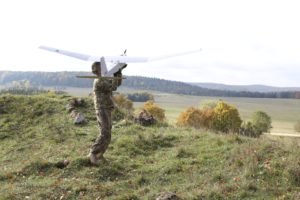Source: U.S. Army
A scene depicting dozens of autonomous drones shifting shape while in midflight isn’t from a trailer of the (inevitable) Transformers sequel. It’s a soon-to-be reality for the U.S. Army.
Researchers with the U.S. Army’s Combat Capabilities Development Command’s Army Research Laboratory and Texas A&M University recently presented findings from a two-year study at the AIAA Aviation Forum and Exposition’s virtual event.
According to an army press release, the research project will “be able to rapidly optimize the structural configuration for Future Vertical Lift vehicles while properly accounting for the interaction between air and the structure.”
“Consider an [Intelligence, Surveillance and Reconnaissance] mission where the vehicle needs to get quickly to station, or dash, and then attempt to stay on station for as long as possible, or loiter,” said Francis Phillips, an aerospace engineer at the laboratory. “During dash segments, short wings are desirable in order to go fast and be more maneuverable, but for loiter segments, long wings are desirable in order to enable low power, high endurance flight.”
One challenge for these mighty morphin’ autonomous drones is finding a “balance between sufficient bending stiffness and softness to enable [the shape shifting],” Phillips said. “If the wing bends too much, then the theoretical benefits of the morphing could be negated and also could lead to control issues and instabilities.”
To overcome these challenges, researchers developed a process that decouples the fluid and structural solvers, which can reduce the computational cost for a single run by as much as 80 percent, Phillips said.
“This research will have a direct impact on the ability to generate vehicles for the future warfighter,” Phillips said. “By reducing the computational cost for fluid-structure interaction analysis, structural optimization of future vertical lift vehicles can be accomplished in a much shorter time-frame.”
Phillips added that future soldiers will be able to use this tool to manufacture optimized custom air vehicles for mission specific uses.
Earlier this year, the army’s drone development command presented the FirePoint C3 Challenge in which three academic teams collaborated remotely to design next-generation drone systems for the army.
Presented by the FirePoint Innovations Center at Wichita State University and sponsored by the U.S. Army Combat Capabilities Development Command Aviation and Missile Center, the challenge develops new UAV innovation as well as up-and-coming STEM talent. Teams work within one of three areas — lift, energy or airframe.
Jason is a longstanding contributor to DroneLife with an avid interest in all things tech. He focuses on anti-drone technologies and the public safety sector; police, fire, and search and rescue.
Beginning his career as a journalist in 1996, Jason has since written and edited thousands of engaging news articles, blog posts, press releases and online content.
Email Jason
TWITTER:@JasonPReagan
Subscribe to DroneLife here.
https://dronelife.com/2020/06/26/army-autonomous-drones/
 Unmanned Aerial Vehicle The latest drone news
Unmanned Aerial Vehicle The latest drone news





